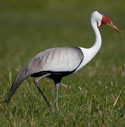|
Family: Gruidae (cranes)
Life
> Eukaryotes >
Opisthokonta
> Metazoa (animals) >
Bilateria >
Deuterostomia > Chordata >
Craniata > Vertebrata (vertebrates) > Gnathostomata (jawed
vertebrates) > Teleostomi (teleost fish) > Osteichthyes (bony fish) > Class:
Sarcopterygii (lobe-finned
fish) > Stegocephalia (terrestrial
vertebrates) > Tetrapoda
(four-legged vertebrates) > Reptiliomorpha > Amniota >
Reptilia (reptiles) >
Romeriida > Diapsida > Archosauromorpha > Archosauria >
Dinosauria
(dinosaurs) > Saurischia > Theropoda (bipedal predatory dinosaurs) >
Coelurosauria > Maniraptora > Aves
(birds) > Order: Gruiformes
Species indigenous to southern Africa
|
Anthropoides
paradiseus (Blue crane) |
 |
|
Balearica
regulorum (Grey Crowned crane, Crowned crane)
The Grey crowned crane occurs from Kenya and Uganda south to southern
Africa, where it breeds on marshes and pans, moving into cultivated areas in
the non-breeding season. It is omnivorous, feeding on a range of seeds,
leaves as well as locusts, grasshoppers, worms and small vertebrates. Its
nest is a mound of aquatic vegetation, often placed in shallow water. It
lays 2-4 eggs, which are incubated for 29-31 days, by both sexes, sharing
the shifts equally. The chicks leave the nest within hours of hatching,
staying in the 100 m vicinity of the nest for at least two weeks. They learn
to fly when they are 56-100 days old, only becoming independent at least 120
days old. |
 |
|
Bugeranus
carunculatus (Wattled crane) |
 |
|
